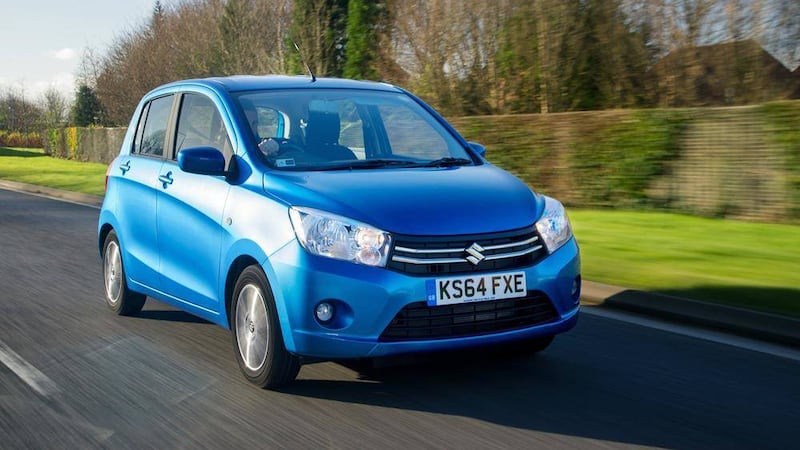I'LL start by putting my cards on the table: I really like Suzuki.
But even I approached the dinky little car on this page, which rejoices in the unpromising name 'Celerio' (celery? celeriac?), with a slight air of trepidation.
First, there's the way it looks. The Celerio is an exemplar of the 'car as a box on wheels' design school, in its case a tall box with wheels that look if not like castors then at least a size too small.
Second, there was the unfortunate business of how the brake pedal on two separate Celerios collapsed when journalists at Autocar magazine were putting the car through its paces.
There's not much that can be done about the Celerio's styling, though it is eminently practical and, when the car in question is so small, it's no bad idea to maximise the square footage of space for passengers and luggage where possible.
And, in fairness, there are a couple of eye-catching touches that show the designers at least tried: the ribbed roof panel and the strong grille and headlamp treatment, for example.
Beauty is in the eye of the beholder in any case, but the brake pedal issue is something that could have potentially affected anyone.
Kudos, then, to Suzuki for rectifying the problem as soon as possible, and turning what could have been a lingering shadow over the Celerio into a positive development.
The brake collapse was caused, believe it or not, by a safety feature designed to move the pedals away from the feet of the driver in the event of a crash. The Autocar team experienced their failure during a particular extreme test - an emergency stop from 70mph - which puts an awful lot of energy into the braking system and, in the Celerio's case, effectively mimicking the force of a crash.
Suzuki redesigned the brake pedal linkage, beefing it up, and thus equipped the Celerio has since sailed through the rigours of the Autocar test. In other words, anyone who fancies performing a maximum-force emergency stop from 70mph should have nothing to worry about.
Not that such extreme manoeuvres are what the Celerio is all about. This is a city car, an urban shopping trolley aimed at the sort of person who might also be considering putting their money into something like a Volkswagen Up and its Seat Mii and Skoda Citigo siblings or a Hyundai i20.
The Celerio is cheaper than any of those but feels roomier, an impression aided by extremely generous headroom and large windows. Back seat passengers will also feel like they have more space than they would in rival cars and the boot is the largest in the class, at 254 litres.
You might get plenty of room but what you don't get are the acres of plush touch-feely plastics, surfaces and switches that Volkswagen and Hyundai tempt you with.
Still, it is well put together and has a robust simplicity which is perfectly appropriate for this sort of car. The Celerio is also well equipped - Bluetooth, DAB radio, USB socket and air conditioning were all aboard the SZ4 spec test car. The driver's seat deserves a special mention, too - one of the more comfortable pews I've sat on in any car recently.
A class-norm three-cylinder 1.0-litre petrol engine is under the bonnet. Fire it up and erupts with an enthusiastic throb.
Once on the move, it's reasonably quiet and has the same smooth-revving characteristic of other triples. The Celerio isn't a quick car by any means but well chosen ratios in the five-speed gearbox mean it is able to sit comfortably at 70mph on the motorway and also zip around town.
So far the Celerio has shown itself to be an accomplished little performer, but it's on a B-road, of all places, that it really shines.
Suzuki's expertise at making a car flow along the road makes itself felt: an excellent gearchange makes stirring the ratios a pleasure as you work to keep the engine in the sweet spot of its admittedly humble power band and the suspension is somehow more supple and controlled than a car of this sort generally benefits from.
You don't so much throw it at corners in the way you might a Mini, but the Celerio does allow you to play around with grip and balance in a way that is far more interesting than other teeny cars.
And, given the Celerio's early difficulties, I can confirm that it brakes strongly and surely - nothing to worry about there.
Even driven enthusiastically, and with more motorway miles than a car of this sort might typically encounter, the Celerio is remarkably frugal - this is a cheap car not only to buy but also to run.
I've driven a few small cars recently - everything from the Citroen C1 and Toyota Aygo to Fiat Panda and Renault Twingo - and the Celerio shows itself to be a highly credible competitor.
Decent equipment, low sticker price, cheap running costs, buckets of space and, perhaps most surprisingly, some real driver enjoyment mean the Celerio is worth serious consideration by anyone in the market for a city car.
And by the time a nice man came to take the little Suzuki away, its looks had even started to grow on me...



